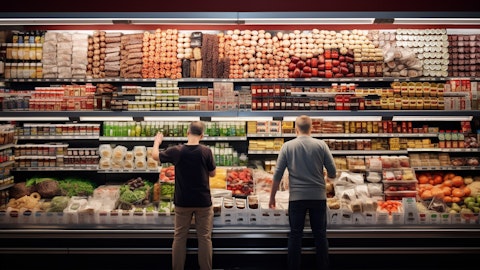We talk a lot about our personalization capabilities at Starbucks, but truly that job is never done because as new technologies and capabilities come online, we are grabbing those and integrating them into our system to use that as a business accelerator. And then lastly, I’d say just making Starbucks more accessible, expanding, as you heard from Laxman, the delivery options you have with Starbucks in a very fast growing part of our business. And then looking at ways to capture more Starbucks Rewards members who are currently not members through big partnerships like the one we’ve just announced with Bank of America. So between compelling products, really accelerating SR member acquisition efforts and then building our brand as Laxman said to address the fact-based narrative in social media and win our customers and win every visit back, that’s where we’re focused.
Operator: Your next question comes from Peter Saleh with BTIG.
Peter Saleh: Great, thanks for taking the question. I did want to ask about the check dynamics going on in China. It looks like down, call it 9%, it’s a pretty steep decline. Just talk about the promotional environment that you’re seeing there and what exactly you guys are doing to combat that and just more specifically should we expect this check impact to really continue for the balance of the year or how do we think about that going forward? Thank you.
Laxman Narasimhan: We have Belinda online here. So maybe I’ll turn this over to Belinda. Do you want to answer that question, please?
Belinda Wong: Okay. Thank you for the question. Let me just address the AT decline first, the average tech decline. First of all, our beverage and food sales were strong and contributed the majority of our comp growth in Q1 and our AT decline, the 9% decline mainly came from two areas. One is slower sales of our higher priced merchandise as our consumers now more cautious in their spending. But the per merchandise category constitutes a relatively small portion of our sales mix. Second, it’s the targeted promotional investments that we’re making to personalize offers and reward customers’ behaviors in order to drive trial vacancy. Now, this enabled us to optimize our sales and margin. And this is powered by China Deep Brew that helps us to design the right offers to the right cohorts of customers at the right time.
So that’s mainly the reasons for decline. You asked about the promotional environment. Let me just say this. The coffee market is evolving, as Lax said, and going through a transition. It’s still early days and it has not yet fully tiered, right? You see mass — influx of mass market competitors focus on fast store expansion and low price tactics to drive trial. This will shake out over time and yes, we are operating under an increased promotional environment. We are not interested in entering the price war. We are focusing on capturing high quality but profitable, sustainable growth. And it is our aim to be the best and lead in the premium market, as Lax has said, which Starbucks has pioneered in China 25 years ago. We will continue to focus on premium experience that is high quality coffee and human connection.
And we have clear strategies to fuel our comp and total growth. As Lax shared the three points, well the three strategies, I’ll add a little bit more colors. We’re going to dial up our beverage food innovation with robust marketing activations on social media and in-store. We’re going to accelerate our digitalization efforts to drive innovations, sales and productivity. We’re going to continue our new store expansion, infill in existing cities and accelerate new county city entry as Lax has said. We are going to dial up our omnichannel expansion, scale up our membership program and continue to invest in our partners. So we have all these strategies to drive out comp growth and total growth in traffic and ticket. So we are very confident in our ability to deliver our growth in a short and long term.
Thank you.
Operator: Your next question comes from Lauren Silberman with Deutsche Bank.
Lauren Silberman: Thank you very much. I want to ask about the US business. I appreciate all the color. I guess two related questions. One, I understand you’re seeing a more significant slowdown with the occasional customer. Have you also seen a slowdown in traffic with rewards customers, or are the challenges really just isolated to occasional, trying to understand some of the breadth of the social media challenges? And then second, you’ve ramped up the level of promotional activities for rewards. Is this effectively hitting the occasional customer? Just trying to understand how you’re thinking about promotional activity ahead. Thank you.
Laxman Narasimhan: Well, let me take this on. First of all, we are seeing no slowdown in our loyal SR customers. In fact, we’re seeing an increase in frequency. They’re buying more. They’re customizing more. That part of the business is extremely strong. We did see, as you rightfully said, a slowdown in the very occasional customers, which we’re still working to get back. But the folks in the middle who are occasional, some of the tactics that we used, which of course you’re seeing, essentially helped bring them back into the fray in terms of the traffic we’ve seen it bounce back towards December. So we’re focused on ensuring that we do the right thing in terms of welcoming back our very occasional customers with the right offer, with the right innovation, and with the right experience in stores.
Operator: Your next question comes from Brian Bittner with Oppenheimer and Company.
Brian Bittner: Thanks for taking the question. Rachel, I wanted to ask about the operating margin expansion in the Americas segment. Obviously, it was very impressive. And it was driven by leverage on your store operating expense line. In fact, when we break it down on a dollar basis, on a same store basis, those operating expenses were actually flattish or even slightly down year-over-year. Can you just unpack what’s going on in that line item? How sustainable is this performance on the operating expense line?
Rachel Ruggeri: Sure. As you look at the store operating expense, it’s largely driven by the activities we’ve taken around our reinvention in in-store operational efficiencies. So that’s a combination of a number of factors, including we’ve focused on operational execution, leveraging standards to be able to manage performance across over 9,700 stores and growing. So that’s been one driver. In addition to that, we’ve had continued improvement in our equipment. And the investments we made in equipment a year ago, as well as the investments we’re currently making, that’s all annualizing and helping to support the favorability that we’re seeing in the margin expansion. And then third is, more recently we focused on improving our overall scheduling.





